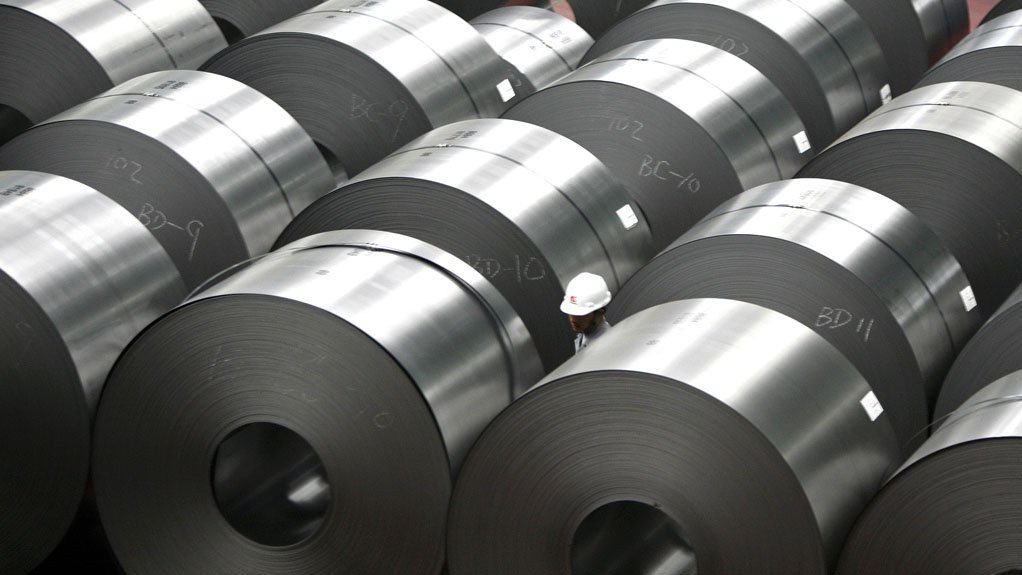China’s latest five-year plan points to further mining consolidation


DEMAND DOWNTURN BMI’s predictions include that China's steel production will register a steady decline, averaging -1.3% year-on-year from 2016 to 2020
Photo by Bloomberg
China’s thirteenth five-year plan points to further consolidation in the mining industry, along with heightened environmental protection, which will affect the steel and coal sectors most, as well as hurt countries that export iron-ore and coal to China, predicts research firm BMI Research.
The firm last month published the ‘Industry Trend Analysis – China’s 13th Five Year Plan Signals Further Mining Consolidation’ report. It noted that it expected the strong support for State-owned entities (SOEs), outlined in the plan, to delay reforms and consolidation plans.
“In light of the mining sector, China’s thireenth five-year plan (5YP), detailing social and economic development guidelines and reform targets for the five-year period from 2016 to 2020, points to a reinforced continuation of strategies from the twelfth 5YP and government policies over the past year,” according to the report.
While the thirteenth 5YP’s priority of over-capacity reduction and heightened consolidation in the mining sector was not addressed in the twelfth 5YP, BMI highlights that government policies over the past year have focused largely on this issue.
Meanwhile, the consolidation of industries with a supply glut, such as coal and steel, will be slow, compared with government’s resolution, BMI Research reports, attributing this to the continued demand for support for SOEs in the thirteenth 5YP.
“The implementation of tough reforms will be further delayed by attempts to mitigate labour unrest fear the collapse of the local banking sector and the government’s known preference of forsaking radical reforms for slow and managed economic transitions,” the report notes.
Meanwhile, the plan’s emphasis on the con-servation of mineral resources will further sup- port the government’s ongoing drive to consoli-date the mining sector, with coal, bauxite, iron-ore, nickel, lead and zinc expected to be among the minerals protected from excessive mining by heightened regulations in the future, according to the report.
This comes as a result of declining reserves and ore grades of these minerals, which threatens China’s resource security, while the polluting nature of mining negates the country’s environmental policies.
With regard to bauxite, BMI Research’s report sug gests that “falling reserves and ore grades will incentivise imports instead of domestic produc- tion”, whereas the fall in Chinese iron-ore grades, from 66% in 2004 to 17% in 2014, will lead to “heightened seaborne import demand for higher-grade ores”.
“This increase in import demand will partially offset the decrease in demand from a severe cooling of domestic steel production, according to the report.
Additionally, BMI Research believes that nickel, zinc and lead mining will also face heightened regulations over the next few years, as lead poisoning is one of China’s fastest-growing health problems.
The report, however, predicts that strong support for SOEs in China’s new thirteenth 5YP will slow -government’s efforts to curb overcapacity in the steel, coal, cement and nonferrous metal sectors.
This effect will be worsened by government’s intent in the new plan to provide oversupplied sectors with fiscal, tax, financial and land policy support to rescue and upgrade their businesses.
Although at a slower pace than announced, the report posits that consolidation will roll on nonetheless. BMI Research, however, expects that smaller, privately owned miners will shut operations or be acquired first, as industries will come to “concentrate around a few large SOEs”.
BMI Research’s predictions include that China’s steel production, the source of demand for coking coal in the country, will register a steady decline – averaging –1.3% year-on-year from 2016 to 2020, compared with 4.9% growth between 2011 and 2015.
“Steel production growth in China has peaked and will remain weak as a result of govern- ment consolidation, low prices and a slowdown in Chinese fixed asset investment,” the report states.
Comments
Press Office
Announcements
What's On
Subscribe to improve your user experience...
Option 1 (equivalent of R125 a month):
Receive a weekly copy of Creamer Media's Engineering News & Mining Weekly magazine
(print copy for those in South Africa and e-magazine for those outside of South Africa)
Receive daily email newsletters
Access to full search results
Access archive of magazine back copies
Access to Projects in Progress
Access to ONE Research Report of your choice in PDF format
Option 2 (equivalent of R375 a month):
All benefits from Option 1
PLUS
Access to Creamer Media's Research Channel Africa for ALL Research Reports, in PDF format, on various industrial and mining sectors
including Electricity; Water; Energy Transition; Hydrogen; Roads, Rail and Ports; Coal; Gold; Platinum; Battery Metals; etc.
Already a subscriber?
Forgotten your password?
Receive weekly copy of Creamer Media's Engineering News & Mining Weekly magazine (print copy for those in South Africa and e-magazine for those outside of South Africa)
➕
Recieve daily email newsletters
➕
Access to full search results
➕
Access archive of magazine back copies
➕
Access to Projects in Progress
➕
Access to ONE Research Report of your choice in PDF format
RESEARCH CHANNEL AFRICA
R4500 (equivalent of R375 a month)
SUBSCRIBEAll benefits from Option 1
➕
Access to Creamer Media's Research Channel Africa for ALL Research Reports on various industrial and mining sectors, in PDF format, including on:
Electricity
➕
Water
➕
Energy Transition
➕
Hydrogen
➕
Roads, Rail and Ports
➕
Coal
➕
Gold
➕
Platinum
➕
Battery Metals
➕
etc.
Receive all benefits from Option 1 or Option 2 delivered to numerous people at your company
➕
Multiple User names and Passwords for simultaneous log-ins
➕
Intranet integration access to all in your organisation


















